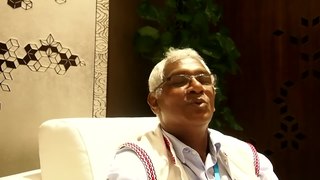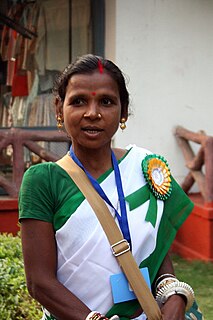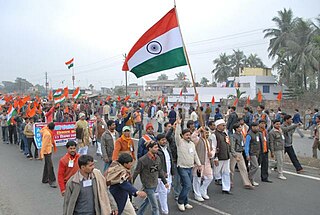
The Munda languages are a group of closely related languages spoken by about nine million people in India and Bangladesh. Historically, they have been called the Kolarian languages. They constitute a branch of the Austroasiatic language family, which means they are more distantly related to languages such as the Mon and Khmer languages, to Vietnamese, as well as to minority languages in Thailand and Laos and the minority Mangic languages of South China. Bhumij, Ho, Mundari, and Santali are notable Munda languages.
Ho is a Munda language of the Austroasiatic language family spoken primarily in India by about 1.04 million people per the 2001 census. Ho is a tribal language. It is spoken by the Ho, Munda, Kolha and Kol tribal communities of Odisha, Jharkhand, Bihar, Chhattisgarh, West Bengal, Assam and is written with the Warang Citi script. Devanagari, Latin script, Odia script and Telugu script are sometimes used, although native speakers are said to prefer a Ho script. The latter script was invented by Ott Guru Kol Lako Bodra.

East Singhbhum is one of the 24 districts of Jharkhand, India. It was created on 16 January 1990. More than 50% of the district is covered by dense forests and mountains, where wild animals once roamed freely. It is known for being a centre of industry since Jamshedpur, the most populous city in Jharkhand, is located here.

The Munda people are an Austroasiatic speaking ethnic group of India. They predominantly speak the Mundari language as their native language, which belongs to the Munda subgroup of Austroasiatic languages. The Munda are found mainly concentrated in the Chhotanagpur Plateau region, which covers most of Jharkhand, as well as in neighboring regions of Bihar, Chhattisgarh, Odisha and West Bengal. The Munda also reside in adjacent areas of Madhya Pradesh as well as in portions of Bangladesh and the state of Tripura. They are one of India's largest scheduled tribes. Munda people in Tripura are also known as Mura, and in Madhya Pradesh they are often called Mudas.

The Kharia are an Austroasiatic tribal ethnic group from east-central India. They originally speak the Kharia language, which belong to Austroasiatic languages. They are sub-divided into three groups known as the Hill Kharia, Delki Kharia and the Dudh Kharia. Amongst them, the Dudh Kharia is the most educated community.

The Kharia language is a Munda language of the Austroasiatic language family, that is primarily spoken by the Kharia people of eastern India.
The tribes of Jharkhand consist of 32 scheduled tribes inhabiting the Jharkhand state in India. In 1872, only 18 tribes were counted among the schedule tribes from which Banjara, Bhatudi, Chik Baraik and Mahli were marked as semi-Hindu aboriginal and Kora as proletariat Hindu. In the 1931 census, including above four semi-Hindu aboriginal and Kora, a proletariat Hindu, the number was raised to 26 from 18 by adding four more in the annexure. They were Birajia, Godait, Karmali and Paharia, but Kisan wad excluded from the list. In 1941 census, Baga, Bedia and Lohra included again taking Kisan in the annexure and number came to 30 which was prevailing till June 2003. Kanwar and Kol were added on 8 June 2003 in the annexure and the number of Schedule Tribes came to 32.

The Ho or Kolha people are an Austroasiatic Munda ethnic group of India. They call themselves the Ho, Hodoko and Horo, which mean 'human' in their own language. Officially, however, they are mentioned in different subgroups like Kolha, Mundari, Munda, Kol and Kolah in Odisha. They are mostly concentrated in the Kolhan region of Jharkhand and Odisha where they constitute around 10.7% and 7.3% of the total Scheduled Tribe population respectively, as of 2011. With a population of approximately 700,000 in the state in 2001, the Ho are the fourth most numerous Scheduled tribe in Jharkhand after the Santals, Kurukhs, and Mundas. Ho also inhabit adjacent areas in the neighboring states of Odisha, West Bengal and Bihar bringing the total to 806,921 as of 2001. They also live in Bangladesh and Nepal.
Birhor people (Birhul) are a tribal/Adivasi forest people, traditionally nomadic, living primarily in the Indian state of Jharkhand. They speak the Birhor language, which belongs to the Munda group of languages of the Austroasiatic language family.
The Birhor language is a highly endangered Munda language spoken by the Birhor people in Chhattisgarh, Odisha, West Bengal, and Maharashtra states in India.

Bhumij is a Munda ethnic group of India. They primarily live in the Indian states of West Bengal, Odisha, and Jharkhand, mostly in the old Singhbhum district. Also in states like Bihar and Assam. There is also a sizeable population found in Bangladesh. Bhumijas speak the Bhumij language, an Austroasiatic language, and use Ol Onal script for writing.

Kurmali or Kudmali is an Indo-Aryan language classified Bihari group of spoken language in eastern India. As a trade dialect, it is also known as Panchpargania, for the "five parganas" of the region it covers in Jharkhand. Kurmali language spoken by around 5.5 lakh people mainly in fringe region Jharkhand, Odisha and West Bengal, also sizable population speak Kurmali in Assam tea valleys. Intellectuals claim that Kurmali may be the nearest form of language used in Charyapada. Kurmali is one of the demanded language for enlisting in Eighth Schedule to the Constitution of India.

Nagpuri is an Indo-Aryan language spoken in the Indian states of Jharkhand, Chhattisgarh, Odisha and Bihar. It is primarily spoken in the west and central Chota Nagpur plateau region.

Dewri Mandir is a mandir situated in Diuri village, Tamar near Ranchi in Jharkhand in India. It is located near the Tata-Ranchi Highway (NH33). The main attraction of this ancient mandir is, 700 year old murti of the Goddess Durga, Kali. The murti have 16 hands. It is an ancient Mandir and It was renovated few years back. The ancient mandir was constructed by interlocking stones without using chalk or binding material. This temple is also known as, Mata Dewri Diri in tribal Bhumij Munda languages.

Language row and movement in Jharkhand are a series of lingual conflicts in Jharkhand, India. The 2021–2022 Language Movement in Jharkhand is a language movement organized on 2021 in Jharkhand, which is still going on in 2022. The people's demand was expressed to protect the local language and to prevent the aggression of other languages on the local language. Local language rights activists in Dhanbad and Bokaro protested against the inclusion of Bhojpuri, Magahi and Maithili languages in the state government's list of regional languages for Dhanbad and Bokaro, and launched a series of movements under the banner of Jharkhandi Bhasa Bachao Sangharsh Samiti. On 30 January 2022, Local language right activists making a 50- km long human chain from Telmachcho to Chandankiyari in Bokaro with intensely protests. The voice of the protesters on that day was "Bahari Bhasa Nei Chalto", means outsiders' languages will not work.
Chaupal, or Choupal are a Dalit Hindu caste who are mainly present in Indian state of Bihar, though they are also present in Assam, Jharkhand, Odisha and West Bengal. They are a sub-group of Khati or Khatwe caste and are designated as Schedule Caste.

Sarhul is a spring festival in the Indian state of Jharkhand. The festival is celebrated for three days, from the 3rd day of Chaitra month in Sukla Paksh to Chaitra Purnima. In the festival, the village priest Pahan offers sacrifice of flowers, fruit, vermilion, rooster and tapan (liquor) in Sarna to Sun, village deity and ancestor for good fortune of the village. Then the locals dance holding flowers of the sal tree. It is a symbol of commencement of the new year. According to the tradition, it also symbolises marriage between the Earth and the Sun. It is an important festival observed by the Kurukh and Sadan. Among Kurukh it is known as Khaddi in Kurukh.

Firkal is a martial art folk-dance of Bhumij tribe. The main instruments of Firkal are swords, arrows, bows and shields. It can be found in Potka block of Jharkhand and some parts of Odisha, India.
Nawakhani is harvest festival of of Jharkhand, Chhattisgarh and Odisha. In this festival people eat new grain of rice after harvesting.
The Turi is a caste found in the state of Jharkhand, Odisha and West Bengal in India. The traditionally involved in the manufacture of household items of bamboo.














